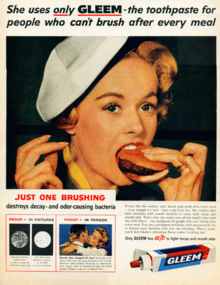Gleem

Gleem was a brand of toothpaste made by the Procter & Gamble company. It was discontinued in 2014. Procter & Gamble now markets the Gleem formulation under the brand name Crest Fresh and White.
Advertisements in the 1950s stated that it has GL-70, a supposed odor- and bacteria-fighting compound. Gleem was introduced in 1952 as a competitor to top Colgate's then top Dental Cream, with advertising coordinated by Compton Advertising, Inc.[1] The League Against Obnoxious TV Commercials included a Gleem toothpaste commercial in its list of the terrible 10 in May 1963.[2] In 1958 Gleem had become number two in top toothpastes, with Colgate still first in sales and Crest in third place. By 1969 Gleem was a declining brand name. In an effort to obtain additional sales, Procter & Gamble assigned the account to the firm of Mary Wells Lawrence, Wells, Rich, Greene.[3]
When Gleem II with fluoride and "green sparkles" was introduced within several years, the brand achieved a 9% share of the toothpaste market. However, this portion declined to around 6% with the introduction of new competing brands. Gleem's main decline was promotion geared toward its take-over competitor, Crest. The difference between Gleem and Crest is Gleem was strictly a 'toothpaste' and originally contained no fluoride. Fluoride was later introduced into Gleem after Crest was first sold in 1955, as a form of consumer competition. While Gleem remained a toothpaste, Crest advanced into flavored 'pastes,' 'gels,' and so on. Until its discontinuance, the Gleem toothpaste package stated 'CONTAINS NO SUGAR' in bold print. Crest has been known to carry increments of sugar as well as artificial flavoring and coloring, aimed at coaxing young children and preteen enticement to prompt oral hygiene. In 1963, Gleem carried a 17-percent share of the toothpaste market in third place, with an advertising budget at $7.1 million. Gleem continued to become less prevalent when the American Dental Association granted Crest approval for the ADA logo. In addition, Crest contains stannous fluoride which has been said to strengthen and protect tooth enamel, calcium and fight gingivitis and bacterial infection, but is often irritant, abrasive and stains, while sodium fluoride (contained in Gleem) is more gentle, does not stain, but requires more application (longer or more brushings) to further prevent bacterial infections and can have little effect with calcium.
In 1975, Gleem was supported by $6 million in television advertising alone. In August 1976, Procter & Gamble transferred Gleem from Wells, Rich, Greene to the Leo Burnett Company of Chicago, Illinois.[4]
See also
References
- ↑ Advertising & Marketing, New York Times, November 21, 1952, Page 36.
- ↑ Offensive Plugs, New York Times, May 19, 1963, Page X17.
- ↑ Procter & Gamble Shifts Billings, New York Times, February 3, 1969, Page 51.
- ↑ P & G Moves Gleem To Burnett, The New York Times, April 14, 1976, Page 50.